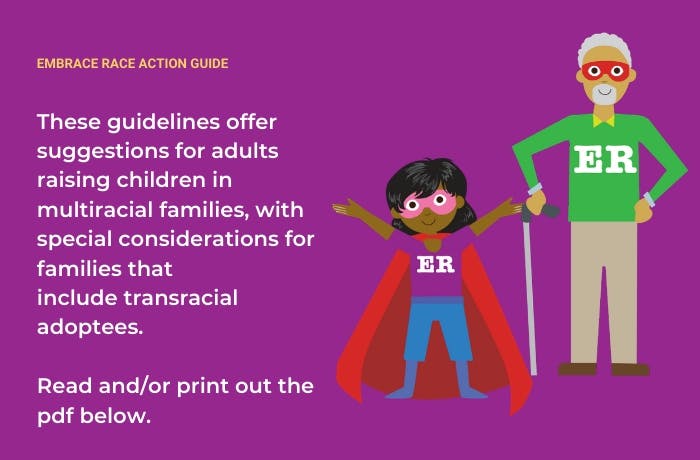Tips for parenting your transracially adopted child
by Gina E. Miranda Samuels, PhD, MSW

I am a transracial adoptee who has spent my professional life working with and conducting research on the experiences of multiracial families and families created by transracial adoption. These guidelines offer suggestions for adults raising children in multiracial families, with special considerations for families that include transracial adoptees. Transracial adoption is a unique context in which children learn about race, ethnicity and culture, and has important implications for how parents can support their children, within and beyond families, to develop healthy racial identities.
Find other resources I recommend, including my recent book, here.
1. Remember that babies can recognize race differences by the age of 6 months old. Children as young as 2 years old will exhibit same-race preferences.
THIS MEANS: From the moment we are born into the world we are taking it all in. Living in ways that socialize your child to fully experience this world naturally and regularly is important even for very young children. If you are waiting for your child to initiate this conversation, it will be too late.
- It requires the family to be fluent in “race talk” – socialization is not a conversation, it is a daily, incremental, and developmental family process.
- Engaging race, ethnicity, culture are normal parts of everyday life. Families should not relegate engaging child’s development around these identities to isolated experiences like culture camps, field trips and things that exist outside of regular family life.
- It requires parents to also live these experiences of multiraciality without their children. Your adopted child should not be the first person of color in your life.
2. Remember that it is normal to have questions about “where you come from” and about one’s birth family and their racial/ethnic/cultural heritage.
Some adopted children never talk with parents or other siblings about their questions. This does not mean they do not think about their birth families, about race, or that it is not important to them, or that its “not an issue.”
THIS MEANS: “Family and Kinship Talk” (discussions about “relatives” and inherited traits, and stories of where “we” come from, etc.) should openly acknowledge child’s birth family as present in those conversations and part of the larger family’s shared story. It can also involve parents needing their own supports to deal with issues they may have about openness in adoption, or insecurities about what it does and does not mean for an adopted child to search for birth family, have “first parents” and families of origin.
Many people change their minds about wanting to search at different moments of their lives. Some people never search for biological families. We are all different. Facebook and DNA searching complicates this process, as sometimes biological family members find adopted family members who do not want to be found. This can take the control out of the hands of the adopted person and parents should be ready for these pathways of searching as well.
3. Not talking about race or being “colorblind” is harmful not helpful to children of color and prevents a family’s ability to authentically connect and be mutually supportive to each other.
THIS MEANS: Avoiding race does not eliminate racism or the reality that race is always present for all of us. Your child is listening and watching you all the time and noticing how you (and those you spend time with) engage, avoid, or diminish issues of race, ethnicity and culture even if you are not directly talking to the child. Thinking in terms of racial appearance: Who do you approach to ask questions? How do you engage people with lighter skin versus darker skin in your day-to-day life? Are there people of color in your day-to-day life, are these people who share a culture of origin with your child? What comments do you or extended family members make about people who look like your child while watching TV? What do you not talk about?
What you say and do not say all directly send messages to your child about whether or not you are a person they can go to with their questions, share their experiences of race with, as well as seek support from when they are hurting. Avoiding it, or claiming to be blind to it, does not control or limit its presence in your or your child’s life. Instead, it leaves your child alone without parental or family support to help navigate these dynamics and limit their harm.
4. When your child comes to you with an experience that has hurt them, do not ask them to prove to you that it was racism, diminish their assessment of it as racially motivated, or avoid identifying it as racism even when you know it was.
THIS MEANS: Spending time asking children if they were “sure” that was about race, or finding ways to explain what happened as something other than racism or discrimination will likely not be experienced by your child as supportive. When your child comes to you in pain, be with them and explore and validate with them how they are feeling. Today, most experiences of racism are very subtle. Spending time proving it was or was not racism takes you away from being present with your child and providing support to them immediately. You can always later find out more information about a situation to know if there is additional action you need to take.
5. Racial identity development is complex and relational. Identities cannot be developed through providing children with same-race dolls, books, or abstract experiences that are disconnected from real people and places.
THIS MEANS: In order for your child to have a sense of connection, pride, or belonging within a racial-ethnic or cultural community, they must have early and ongoing experiences and relationships that anchor these identities. It is through relationships (not dolls, books, race labels or even our biology) that we have lived experiences of ourselves as belonging (or not) within various racial-ethnic and cultural communities. The importance of these relationships is critically relevant for transracial adoptees, as our adoptive families and extended families are not routes to relatives through which we experience and learn about our racial-ethnic and cultural heritages. Parents must be proactive in charting possible pathways for a diversity of experiences to occur naturally and emerge across your child’s life course in a host of racial-ethnic communities.
Gina Miranda Samuels, PhD, MSW



